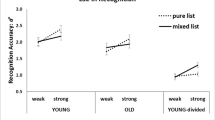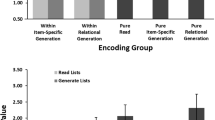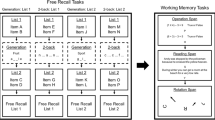Abstract
Drawing a referent of a to-be-remembered word often results in better recognition and recall of this word relative to a control task in which the word is written, a pattern dubbed the drawing effect. Although this effect is not always found in pure lists, we report three experiments in which the drawing effect emerged in both pure- and mixed-lists on recognition and recall tests, though the effect was larger in mixed lists. Our experiments then compared drawing effects on memory between pure- and mixed-list contexts to determine whether the larger mixed-list drawing effect reflected a benefit to draw items, a cost to write items, or a combination. In delayed recognition and free-recall tests, a mixed-list benefit emerged for draw items in which memory for mixed-list draw items was greater than pure-list draw items. This mixed-list drawing benefit was accompanied by a mixed-list writing cost compared to pure-list write items, indicating that the mixed-list drawing effect does not operate cost-free. Our findings of a pure-list drawing effect are consistent with a memory strength account, however, the larger drawing effect in mixed lists suggest that participants may also deploy a distinctiveness heuristic to aid retrieval of drawn items.


Similar content being viewed by others
Notes
Because hit and false alarm rates were perfect for many participants (1.00 or 0.00, respectively), we focus our analyses on raw recognition rates versus a hits-minus-false-alarms correction or dꞌ using signal detection. A signal-detection analysis requires a correction for asymptotic values (e.g., MacMillan & Creelman, 1988), and most participants would have required at least one corrected score to compute dꞌ due to ceiling hits or floor false alarms which would have distorted the dataset.
References
Balota, D.A., Yap, M.J., Hutchison, K.A. et al. The English lexicon project. Behavior Research Methods, 39, 445–459.
Begg, I., & Roe, H. (1988). On the inhibition of reading by generating. Canadian Journal of Psychology, 42, 325–336.
Begg, I., & Snider, A. (1987). The generation effect: Evidence for generalized inhibition. Journal Experimental Psychology: Learning, Memory, and Cognition, 13, 553–563.
Begg, I., Snider, A., Foley, F., & Goddard, R. (1989). The generation effect is no artifact: Generating makes words distinctive. Journal of Experimental Psychology: Learning, Memory, and Cognition, 15, 977–989.
Bertsch, S., Pesta, B. J., Wiscott, R., & McDaniel, M. A. (2007). The generation effect: A meta-analytic review. Memory & Cognition, 35, 201–210.
Bodner, G. E., Taikh, A., & Fawcett, J. M. (2014). Assessing the costs and benefits of production in recognition. Psychonomic Bulletin & Review, 21, 149–154.
Brysbaert, M., & New, B. (2009). Moving beyond Kučera and Francis: A critical evaluation of current word frequency norms and the introduction of a new and improved word frequency measure for American English. Behavior Research Methods, 41, 977–990.
Brysbaert, M., Warriner, A. B., & Kuperman, V. (2014). Concreteness ratings for 40 thousand generally known English word lemmas. Behavior Research Methods, 46, 904–911.
Burnett, A. N., & Bodner, G. E. (2014). Learnin’ ‘bout my generation? Evaluating the effects of generation on encoding, recall, and metamemory across study-test experiences. Journal of Memory and Language, 75, 1–13.
Conway, M. A., & Gathercole, S. E. (1987). Modality and long-term memory. Journal of Memory and Language, 26, 341–361.
Craik, F. I. M., & Lockhart, R. S. (1972). Levels of processing: A framework for memory research. Journal of Verbal Learning & Verbal Behavior, 11, 671–684.
Crowder, R. G. (1976). Principles of Learning and Memory. Lawrence Erlbaum.
deWinstanley, P. A., & Bjork, E. L. (2004). Processing strategies and the generation effect: Implications for making a better reader. Memory & Cognition, 32, 945–955.
Engelkamp, J., & Dehn, D. M. (2000). Item and order information in subject-performed tasks and experimenter-performed tasks. Journal of Experimental Psychology: Learning, Memory, and Cognition, 26, 671–682.
Engelkamp, J., & Krumnacker, H. (1980). Image- and motor-processes in the retention of verbal materials. Zeitschrift für Experimentelle und Angewandte Psychologie, 27, 511–533.
Faul, F., Erdfelder, E., Lang, A.-G., & Buchner, A. (2007). GPower 3: A flexible statistical power analysis program for the social, behavioral, and biomedical sciences. Behavior Research Methods, 39, 175–191.
Fawcett, J. M. (2013). The production effect benefits performance in between-subjects designs: A meta-analysis. Acta Psychologica, 142, 1–5.
Fernandes, M. A., Wammes, J. D., & Meade, M. E. (2018). The surprisingly powerful influence of drawing on memory. Current Directions in Psychological Science, 27(5), 302–308.
Forrin, N. D., MacLeod, C. M., & Ozubko, J. D. (2012). Widening the boundaries of the production effect. Memory & Cognition, 40, 1046–1055.
Hege, A. C. G., & Dodson, C. S. (2004). Why distinctive information reduces false memories: Evidence for both impoverished relational-encoding and distinctiveness heuristic accounts. Journal of Experimental Psychology: Learning, Memory, and Cognition, 30(4), 787–795.
Hopkins, R. H., & Edwards, R. E. (1972). Pronunciation effects in recognition memory. Journal of Verbal Learning & Verbal Behavior, 11, 534–537.
Howard, M. W., & Kahana, M. J. (1999). Contextual variability and serial position effects in free recall. Journal of experimental psychology. Learning, Memory, and Cognition, 25(4), 923-941.
Huff, M. J., & Bodner, G. E. (2019). Item-specific and relational processing both improve recall accuracy in the DRM paradigm. Quarterly Journal of Experimental Psychology, 72, 1493–1506.
Huff, M. J., Bodner, G. E., & Fawcett, J. M. (2015). Effects of distinctive encoding on correct and false memory: A meta-analytic review of costs and benefits and their origins in the DRM paradigm. Psychonomic Bulletin & Review, 22, 349–365.
Icht, M., Mama, M., & Algom, D. (2014). The production effect in memory: Multiple species of distinctiveness. Frontiers in Psychology, 5, 886.
Jones, A. C., & Pyc, M. A. (2014). The production effect: Costs and benefits in free recall. Journal of Experimental Psychology: Learning, Memory, and Cognition, 40, 300–305.
Jonker, T. R., Levene, M., & MacLeod, C. M. (2014). Testing the item-order account of design effects using the production effect. Journal of Experimental Psychology. Learning, Memory, and Cognition, 40, 441–448.
Jonker, T. R., Wammes, J. D., & MacLeod, C. M. (2019). Drawing enhances item information but undermines sequence information in memory. Journal of experimental psychology. Learning, Memory, and Cognition, 45, 689–699.
Kuperman, V., Stadthagen-Gonzalez, H., & Brysbaert, M. (2012). Age-of-acquisition ratings for 30,000 English words. Behavior Research Methods, 44, 978–990.
MacLeod, C. M. (1975). Release from proactive interference: Insufficiency of an attention account. The American Journal of Psychology, 88, 459–465.
MacLeod, C. M., & Bodner, G. E. (2017). The production effect in memory. Current Directions in Psychological Science, 26, 390–395.
MacLeod, C. M., Gopie, N., Hourihan, K. L., Neary, K. R., & Ozubko, J. D. (2010). The production effect: Delineation of a phenomenon. Journal of Experimental Psychology: Learning, Memory, and Cognition, 36, 671–685.
Macmillan, N. A., & Creelman, C. D. (1991). Detection Theory: A User’s Guide. Cambridge University Press.
McDaniel, M. A., & Bugg, J. M. (2008). Instability in memory phenomena: A common puzzle and a unifying explanation. Psychonomic Bulletin & Review, 15, 237–255.
McDaniel, M. A., & Einstein, G. O. (1986). Bizarre imagery as an effective memory aid: The importance of distinctiveness. Journal of Experimental Psychology: Learning, Memory, and Cognition, 12, 54–65.
McDaniel, M. A., Waddill, P. J., & Einstein, G. O. (1988). A contextual account of the generation effect: A three-factor theory. Journal of Memory and Language, 27, 521–536.
Meade, M. E., Wammes, J. D., & Fernandes, M. A. (2018). Drawing as an encoding tool: Memorial benefits in younger and older adults. Experimental Aging Research, 44, 369–396.
Murdock, B. B. (1962). The serial position effect of free recall. Journal of Experimental Psychology, 64, 482–488.
Nairne, J. S., Thompson, S. R., & Pandeirada, J. N. S. (2007). A990.daptive memory: Survival processing enhances retention. Journal of Experimental Psychology: Learning, Memory, and Cognition, 33, 263–273.
Namias, J. M., Huff, M. J., Smith, A., & Maxwell, N. P. (2022). Drawing individual images benefits recognition accuracy in the Deese-Roediger-McDermott paradigm. Quarterly Journal of Experimental Psychology, 75, 1571–1582.
Pexman, P. M., Muraki, E., Sidhu, D. M., Siakaluk, P. D., & Yap, M. J. (2019). Quantifying sensorimotor experience: Body-object interaction ratings for more than 9,000 English words. Behavior Research Methods, 51, 453–466.
Polyn, S. M., Norman, K. A., & Kahana, M. J. (2009). A context maintenance and retrieval model of organizational processes in free recall. Psychological Review, 116, 129–156.
Roberts, B. R. T., MacLeod, C. M., & Fernandes, M. A. (2022). The enactment effect: A systematic review and meta-analysis of behavioral, neuroimaging, and patient studies. Psychological Bulletin, 148, 397–434.
Roediger, H. L., & McDermott, K. B. (1995). Creating false memories: Remembering words not presented in lists. Journal of Experimental Psychology: Learning, Memory, and Cognition, 21, 803–814.
Schacter, D. L., Israel, L., & Racine, C. (1999). Suppressing false recognition in younger and older adults: The distinctiveness heuristic. Journal of Memory and Language, 40, 1–24.
Schonfield, D., & Robertson, B.-A. (1966). Memory storage and aging. Canadian Journal of Experimental Psychology, 20, 228–236.
Slamecka, N. J., & Graf, P. (1978). The generation effect: Delineation of a phenomenon. Journal of Experimental Psychology: Human Learning and Memory, 4, 592–604.
Slamecka, N. J., & Katsaiti, L. T. (1987). The generation effect as an artifact of selective displaced rehearsal. Journal of Memory and Language, 26, 589–607.
van Doorn, J., & ven den Bergh, D., Böhm, U., Dablander, F., Derks, K., Draws, T. … Wagenmakers, E.-J. (2021). The JASP guidelines for conducting and reporting a Bayesian analysis. Behavior Research Methods, 28, 813–826.
Wahlheim, C. N., & Huff, M. J. (2015). Age differences in the focus of retrieval: Evidence from dual-list free recall. Psychology and Aging, 30, 768–780.
Wammes, J. D., Meade, M. E., & Fernandes, M. A. (2016). The drawing effect: Evidence for reliable and robust memory benefits in free recall. Quarterly Journal of Experimental Psychology, 69, 1752–1776.
Wammes, J. D., Meade, M. E., & Fernandes, M. A. (2017). Learning terms and definitions: Drawing and the role of elaborative encoding. Acta Psychologica, 179, 104–113.
Wammes, J. D., Meade, M. E., & Fernandes, M. A. (2018). Creating a recollection-based memory though drawing. Journal of Experimental Psychology: Learning, Memory, and Cognition, 44, 734–751.
Wickens, D. D., Born, D. G., & Allen, C. K. (1963). Proactive inhibition and item similarity in short-term memory. Journal of Verbal Learning and Verbal Behavior, 2, 440–445.
Yonelinas, A. P. (2002). The nature of recollection and familiarity. A review of 30 years of research. Journal of Memory and Language, 46, 441–517.
Authors’ note
Data collected were used for partial fulfillment of the Honor’s thesis requirements for P.P. Subject level data reported are available on our Open Science Framework page (osf.io/5wx4m).
Author information
Authors and Affiliations
Corresponding author
Additional information
Publisher's Note
Springer Nature remains neutral with regard to jurisdictional claims in published maps and institutional affiliations.
Open practices statement
Data for Experiments 1, 2, and 3 are available at osf.io/5wx4m. Study materials are available upon request.
Rights and permissions
Springer Nature or its licensor (e.g. a society or other partner) holds exclusive rights to this article under a publishing agreement with the author(s) or other rightsholder(s); author self-archiving of the accepted manuscript version of this article is solely governed by the terms of such publishing agreement and applicable law.
About this article
Cite this article
Huff, M.J., Namias, J.M. & Poe, P. The drawing effect: Evidence for costs and benefits using pure and mixed lists. Mem Cogn (2024). https://doi.org/10.3758/s13421-024-01551-6
Accepted:
Published:
DOI: https://doi.org/10.3758/s13421-024-01551-6




